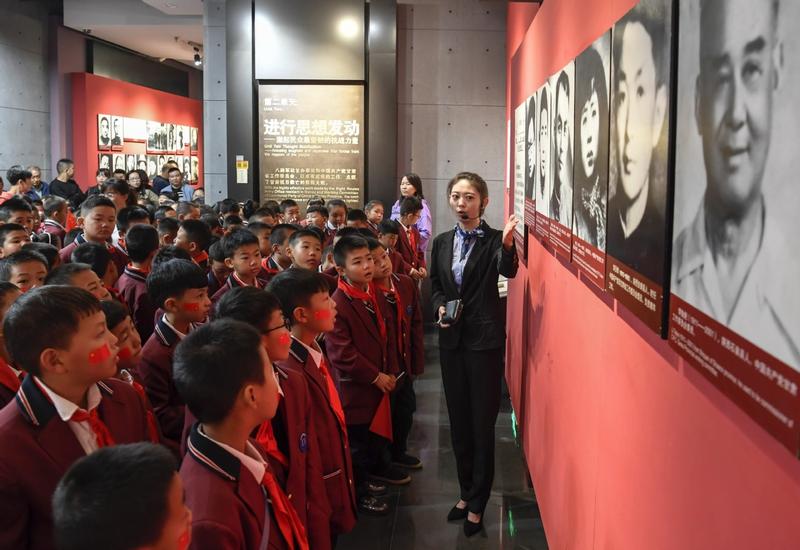The northwestern province of Gansu will use its links with the Long March to generate more tourist income and improve living standards
 Students visit a memorial hall in the former offices of the Eighth Route Army in Lanzhou, capital of Gansu province. (YU JIE / FOR CHINA DAILY)
Students visit a memorial hall in the former offices of the Eighth Route Army in Lanzhou, capital of Gansu province. (YU JIE / FOR CHINA DAILY)
In recognition of its place in the history of the Communist Party of China, the northwestern province of Gansu has made great efforts to transform itself into a Red tourism destination.
Acknowledged as one of the CPC's vital strongholds in the northwest, the Shangan (Shaanxi-Gansu) Revolutionary Base, located near the border with neighboring Shaanxi province, played an important role during the Long March (1934-36).
Gansu was the province that saw the largest number of troops from the Red Army, a predecessor of the People's Liberation Army, passing through during the Long March.
We set up a data center in 2006 and entered a period where we sought innovative techniques to help promote Dunhuang’s cultural treasures. That search is ongoing
Du Juan, vice-director of the Dunhuang Academy’s new media center
Following the founding of the People's Republic of China in 1949, it was the site of the nation's first petrochemicals base and the largest launch site for satellites.
The vast province, redolent of the glory and spirit passed down by generations of revolutionaries, has boosted its economy via the prosperity of the Red tourism sector.
At present, the province has 14 A-rated attractions that highlight Red tourism. One of them is Huining county, where the three main forces of the Red Army were united on Oct 9, 1936, marking a successful end to the Long March for some of the troops.
In 1996, the rendezvous site was listed as a national cultural relic by the State Council, China's Cabinet, and it became one of the nation's first batch of patriotic education bases in the following year.
In recent decades, the Huining site has seen a growing number of visitors, with the average annual number exceeding 100,000, according to the provincial publicity department.
Other Red tourism destinations in the province have also become popular attractions. Statistics from the provincial culture and tourism bureau show that in 2016, Gansu's Red tourism spots received more than 19 million visitors.
In 2019, the number surged to 41.3 million, up 31.3 percent from the previous year, generating related revenue of 11.8 billion yuan (US$1.8 billion).
Chen Weizhong, director of the Gansu Culture and Tourism Bureau, said the province has made great efforts to attract more visitors so the younger generation can learn about the stories and spirit of the revolutionaries.
At the same time, he noted that the province still needs to do more to shore up weak spots, such as a shortage of capital, poor development capabilities, repetitive products and a low talent bank.
Chen said that in the near future, the provincial government will channel efforts and resources to strengthen the market. It has set a target of 80 million visits to its Red tourism sites during the period of the 14th Five-Year Plan (2021-25) to generate revenue of 20 billion yuan.
Furthermore, by 2025, more than 100,000 people will have found jobs in the Red tourism industry every year during the period, making the sector a pillar industry for the province.
The authorities have also released a range of policies to optimize the development of Red tourism. A recent guideline said the provincial government will devise higher standards for the sector, making it a vital part of Gansu's economic development.
Higher-quality tourist products will also be provided. The guideline said the government will focus on promoting four travel routes and 30 classic scenic spots, including Long March routes connecting Yinchuan, capital of the Ningxia Hui autonomous region, and Huining.
Gansu's government will also raise awareness of its Red tourism attractions via high-level exhibitions and online media. It has pledged to build a number of museums to highlight Gansu's Red history, and will also renovate wartime relics.
Related services will also be improved to provide better tourist experiences.
Contact the writers at chengsi@chinadaily.com.cn


